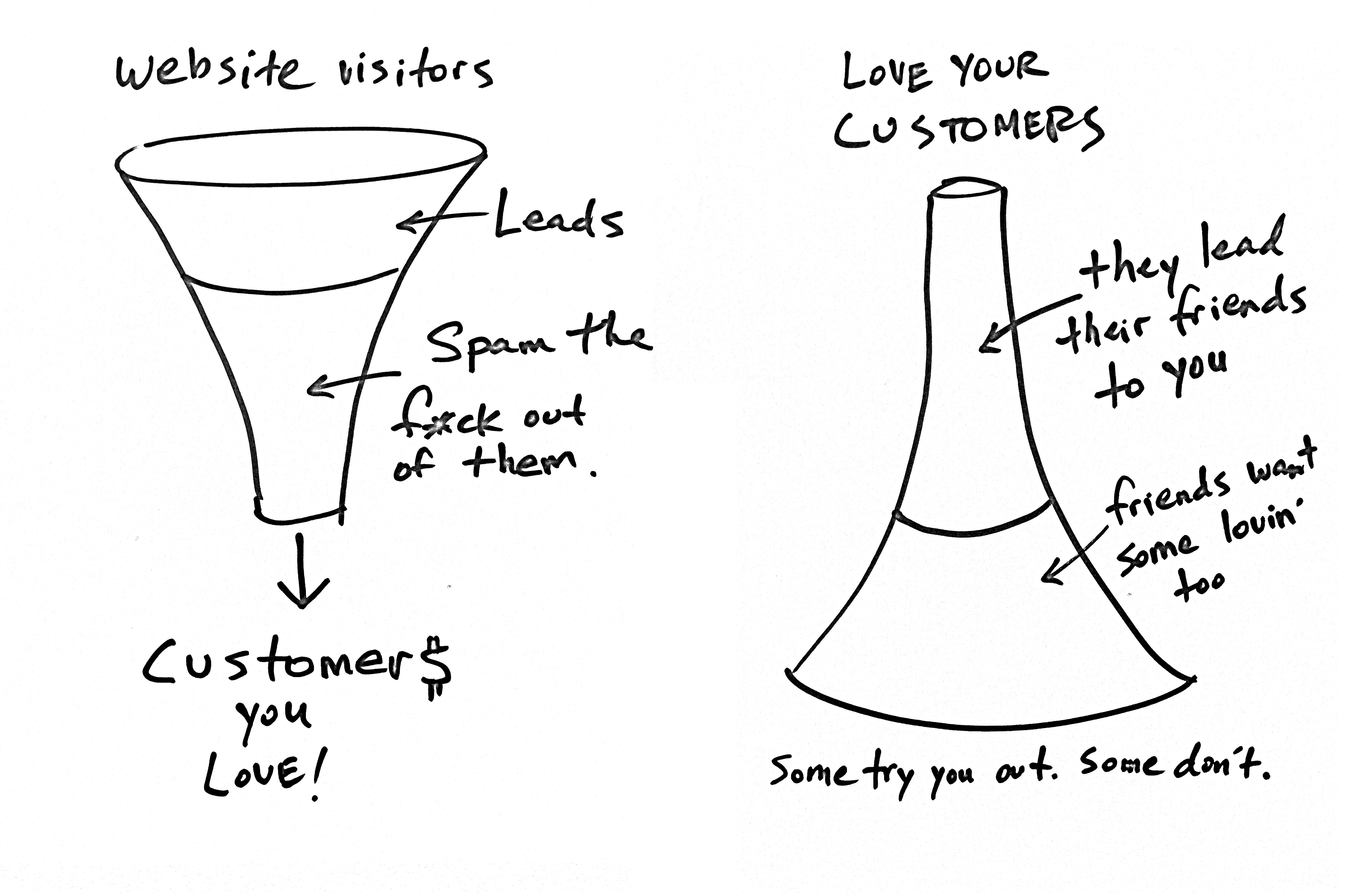
I'm a software engineer and founder currently looking for inspiration to strike for my next big venture as I travel the globe ✈🌎
This is where I put stuff I find interesting.
© 2021 Andreas Heiberg
Fascinating science of how introducing predators can counter-intuitively stimulate entire new ecosystems of birds, plants, land- and amphibious animals.
This gives more credence to the equally fascinating idea of reviving the woolly mammoth.
(via)
I love solutions to very niche problems. I was visiting the London Design Museum the other day and fell over Moocall. It’s basically an activity tracker attached to the cows tail that is able to detect when the cow is going into labour and alert the farmer. What an ingenious use of simple technology to create lots of value.
It’s hard to explain why this episode of 99 percent invisible resonated so much with me. Perhaps it’s the fact that I briefly was a wheelchair user in my youth. In any case, I find it intriguing that the fight for desegregation of abled as well as disabled people happened in parallel on different sides of the US.
Furthermore, I love the fact that I now have a word to describe “curb cuts” in design.
In universal design, there’s something called the curb cut effect. Basically, things intended to benefit people with disabilities wind up benefiting everyone. Curb cuts, which are intended for wheelchair users to be able to get on sidewalks, help bicyclists, parents with strollers, delivery people, and a dozen other nondisabled groups. Similarly, closed captioning, which was originally meant to benefit Deaf people, helps people who have trouble with auditory information processing (hi!), people who like talking during films, and people trying to watch TV in noisy bars. – ozymandias
(via)
On sunny days in the Amazon you may get lucky while boating down the river to see this odd spectacle - dozens of butterflies swarming turtles to drink their tears. Why? Watch to find out.
(via)
If you switch supermarkets because a clerk was snide with you, it removes $50,000 from the store’s ongoing revenue. – Seth Godin
Interesting reminder of the long term value we consumers have to companies and why cutting coners short term can be detrimental to business. Very timely as I just cancelled my idmobile telephone subscription because of a bad experience.
(via)
Your group of friends are better than any drug or anti-aging supplement, and will do more for you than just about anything.
(via)
The FDA’s growing emphasis on speed has come at the urging of both patient advocacy groups and industry, which began in 1992 to contribute to the salaries of the agency’s drug reviewers in exchange for time limits on reviews. In 2017, pharma paid 75 percent — or $905 million — of the agency’s scientific review budgets for branded and generic drugs, compared to 27 percent in 1993.
(via)
“Which one do you want?”
There were 100 quarts of strawberries at the farmer’s market yesterday. In answer to the farmer’s question, the person ahead of me in line spent a full minute looking them all over before picking one.
The thing is: 90% of the strawberries in a quart are hidden from view. They’re beneath the top layer. There’s no strategy to tell which quart is better than the other, unless you (erroneously) believe that the top layer is an accurate indicator of what lies below. – Seth Godin
Great example of an interaction I would find silly without quite being able to succinctly put my finger on why. I’m not sure I buy the analogies drawn from the story, but it struck a cord.
(via)
Ice skating requires two things: smooth ice and gravity. Without a reliable foundation, you can’t move forward. And without the constraints and boundaries put on us by gravity, you can’t move at all. … [The free market needs] clean air and water, a civil society, an educated workforce, a confident and trusting market and more. The very taxes that some whine about are the gravity that makes the system work. – Seth Godin
This reframing of the free market really resonated with me. Seth Godin is spot on as he so often is.
(via)
I was listening to an episode of Tim Ferriss’s podcast with Steve Jurvetson the other day. Steve it turns out has been investing in Quantum Computer startups since 2003. He introduced me to Rose’s law and the incredible pace at which the computational power of Quantum Computers is increasing. I found it very inspiring and would recommend giving it a listen.
I’ve dug out his original post about Rose’s law here.

[Geordie Rose] went on to suggest that the number of qubits in a scalable quantum computing architecture should double every year. It sounded a lot like Gordon Moore’s prediction back in 1965, when he extrapolated from just five data points on a log-scale. … Like Moore’s Law, a straight line describes an exponential. But unlike Moore’s Law, the computational power of the quantum computer should grow exponentially with the number of entangled qubits as well. It’s like Moore’s Law compounded. … And now, it gets mind bending. If we suspend disbelief for a moment, and use D-Wave’s early data on processing power scaling (more on that below), then the very near future should be the watershed moment, where quantum computers surpass conventional computers and never look back. Moore’s Law cannot catch up. A year later, it outperforms all computers on Earth combined. Double qubits again the following year, and it outperforms the universe. What the???? you may ask… Meaning, it could solve certain problems that could not be solved by any non-quantum computer, even if the entire mass and energy of the universe was at its disposal and molded into the best possible computer. – Steve Jurvetson
I read some great answers on the quantum computing stackexchange highlighting that D-Wave is not a general quantum computer and further that it might be too early to establish a law. Both of which are addressed in Steve’s original post, but certainly fair points to the highlight for the particular question. Regardless of these gotchas, I find it incredibly inspiring to think that even the breakneck speed of Moore’s law might is being surpassed in a practically applicable field. I had until hearing about Rose’s law thought quantum computers were at a far more experimental and academic state than appears to be the case. Very exciting!
This is self-reinforcing in practice: as quality impacts predictability and therefore increases risk of change, so teams become more cautious and it becomes harder to make improvements. – Evan Bottcher
It’s a cycle that can be incredibly hard for institutions to break. I don’t think there’s a way of internalising the cost of entering this cycle. But having observed it first hand I will take incredible care to prevent it early in future endeavours.
(via)
- Add energy to every conversation
- Ask why
- Find obsolete things on your task list and remove them
- Treat customers better than they expect
- Offer to help co-workers before they ask
- Feed the plants
- Leave things more organized than you found them
- Invent a moment of silliness
- Highlight good work from your peers
- Find other great employees to join the team
- Cut costs
- Help invent a new product or service that people really want
- Get smarter at your job through training or books
- Encourage curiosity
- Surface and highlight difficult decisions
- Figure out what didn’t work
- Organize the bookshelf
- Start a club
- Tell a joke at no one’s expense
- Smile a lot.
(via)
Why worry about the things you can’t control when you can keep yourself busy controlling the things that depend on you. – John C. Maxwell

If it resonates with you, you should check out dailystoic.com.
(via)
Jeff Atwood wrote a great post about the ethics of programming and the products we create. It’s a natural question to ponder as we see a handful of tech companies amass unpresendented power. Recent events such as the Facebook-Cambridge Analytica scandal or Ubers various scandals and crashes certainly doesn’t help the common opinion that tech is unambiguously good.
I and Jeff share the wunderful experince of accidentally finding software development to subsequently realise that only imagination is the limit to creation. It’s super empowering, but as should be clear to everyone by now, not everything should be created.
I echo his belief that we should do more to ensure that software has a positive impact – as he’s done with StackOverflow and Discourse.
I also continue to believe, if we start to think more holistically about what our software can do to serve all people, not just ourselves personally (or, even worse, the company we work for) — that software can and should be part of the solution. – Jeff Atwood
If you’re interested in examples of how well intentioned tech has unintended negative consequences I would recommend reading “Weapons of Math Destruction” by Cathy O’Neil who also did a Ted talk about it.
P.S. I love this quote from Jeff’s post:
It should be noted that no ethically-trained software engineer would ever consent to write a
DestroyBaghdadprocedure. Basic professional ethics would instead require him to write aDestroyCityprocedure, to which Baghdad could be given as a parameter. – Nathaniel Borenstein
(via)
I recently saw Paul Graham’s 6 level taxonomy for disagreeing referenced for the first time. It’s a great framework that I will be sure to use in the future.
DH0. Name-calling. The author is a self-important dilettante.
DH1. Ad Hominem. Of course he would say that. He’s a senator.
DH2. Responding to Tone. I can’t believe the author dismisses intelligent design in such a cavalier fashion.
DH3. Contradiction. I can’t believe the author dismisses intelligent design in such a cavalier fashion. Intelligent design is a legitimate scientific theory.
DH4. Counterargument. Counterargument is contradiction plus reasoning and/or evidence. When aimed squarely at the original argument, it can be convincing. But unfortunately it’s common for counterarguments to be aimed at something slightly different. More often than not, two people arguing passionately about something are actually arguing about two different things. Sometimes they even agree with one another, but are so caught up in their squabble they don’t realize it.
DH5. Refutation.
quotation
But this is wrong for the following reasons…
DH6. Refuting the Central Point. The author’s main point seems to be x. As he says:
quotation
But this is wrong for the following reasons…
(via)
Media carries with it a credibility that is totally undeserved. You have all experienced this, in what I call the Murray Gell-Mann Amnesia effect. (I call it by this name because I once discussed it with Murray Gell-Mann, and by dropping a famous name I imply greater importance to myself, and to the effect, than it would otherwise have.)
Briefly stated, the Gell-Mann Amnesia effect works as follows. You open the newspaper to an article on some subject you know well. In Murray’s case, physics. In mine, show business. You read the article and see the journalist has absolutely no understanding of either the facts or the issues. Often, the article is so wrong it actually presents the story backward-reversing cause and effect. I call these the “wet streets cause rain” stories. Paper’s full of them.
In any case, you read with exasperation or amusement the multiple errors in a story-and then turn the page to national or international affairs, and read with renewed interest as if the rest of the newspaper was somehow more accurate about far-off Palestine than it was about the story you just read. You turn the page, and forget what you know.
That is the Gell-Mann Amnesia effect. I’d point out it does not operate in other arenas of life. In ordinary life, if somebody consistently exaggerates or lies to you, you soon discount everything they say. In court, there is the legal doctrine of falsus in uno, falsus in omnibus, which means untruthful in one part, untruthful in all.
But when it comes to the media, we believe against evidence that it is probably worth our time to read other parts of the paper. When, in fact, it almost certainly isn’t. The only possible explanation for our behavior is amnesia. – Michael Crichton, Why Speculate, 2002
(via)

I have a great admiration for Mailchimp. They’ve managed to bootstrap a wonderful business and staied true their passion which is why their branding resonates so well. I was just reminded of Ben’s great post about flipping the marketing funnel on it’s head.
Working on the DueDil codebase was my first encounter with a “legacy” application. Consulting and startup land has shielded me from this experience. When maintaining and improving such applications you get an appreciation for commit messages. It can be a saving grace when inspecting the git log reveals a fleshed out train of thought for why the code you’re looking at was modified the way it was. I’ve been saved enough times that I’ve started paying forward my dues over the last 2 years. One recent addition has been getting more systematic about how I style my commit messages.
I’ve adopted the AngularJS convention for prefixing commit messages with feat, fix, docs, style, refactor, perf, test or chore. It’s a small thing, but it’s great when reviewing a bunch of commits.
feat: A new feature
fix: A bug fix
docs: Documentation only changes
style: Changes that do not affect the meaning of the code (white-space, formatting, missing semi-colons, etc)
refactor: A code change that neither fixes a bug nor adds a feature
perf: A code change that improves performance
test: Adding missing or correcting existing tests
chore: Changes to the build process or auxiliary tools and libraries such as documentation generation
For a comprehensive read on writing better commit messages, I suggest this piece.
The argument that makes most sense to me, however, is the separation between intention and implementation. If you have to spend effort into looking at a fragment of code to figure out what it’s doing, then you should extract it into a function and name the function after that “what”. That way when you read it again, the purpose of the function leaps right out at you, and most of the time you won’t need to care about how the function fulfills its purpose - which is the body of the function. – Martin Fowler
Healthy reminder to reduce function lengths. (via)
I’ve had this bookmarked since 2014 and find it no less satisfying to watch 4 years later. Who knew there was room to reinvent the door.
(via)
I would love to get into mechanical engineering for a hobby project. This project strikes a chord with me. I would love to give replicating it a try.
I’ve recently been doing a course on computer graphics. It’s an interesting topic with lots of neat little issues with rather simple solution. Like rasterization, perspective projections, lighting and most recently for my course the drawing of smooth lines and surfaces.
While studying I found this impressive page/book on bezier curves. I’m super amazed by the amount of hard work that evidently went into this. I’ve had similar aspirations countless times, but I’ve felt short every time. Thanks to Mike Kamermans for staying the course, impressive work.
Another great online resource is this UC Davis course on computer graphics.